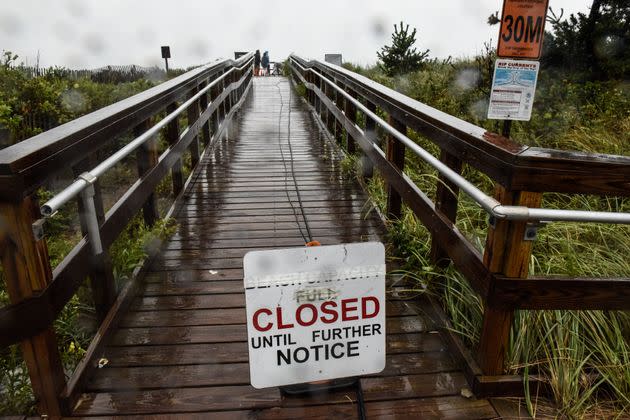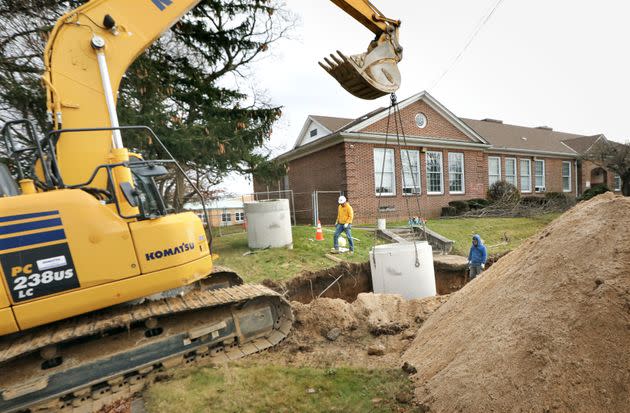Long Island Republicans Block Water Cleanup Effort In Bid To Suppress Democratic Turnout

A sign announces a beach closure on August 22, 2021, in Montauk, New York.
Over the past century, Long Island has transformed from the nation’s first suburb into one of its most densely inhabited as New York City inches eastward on the strip of glacial sand and rocks that already contains its two most populous boroughs. But the beaches, clam shacks and marshy, trout-filled streams that made a destination out of Suffolk County, stretching from the center of the island to Montauk, are now at risk of — to put it in the local parlance — going to shit.
The aging septic tanks into which the toilets and showers in much of the region’s single-family homes drain are leaching huge amounts of nitrogen into waterways, triggering blooms of blue-green algae — so toxic it kills elephants — at twice the frequency of any other county in the state. Fish are dying by the thousands every year and washing up on beaches. Already threatened by salt water from rising seas, the underground freshwater aquifer that provides Long Island’s drinking water is contaminated with surging levels of nitrogen.
The problem is, new “advanced” septic tanks that filter out nitrogen typically cost at least twice as much as traditional models — a hard investment to stomach for homeowners paying some of the highest property taxes and housing costs in the country.
So Suffolk County went through a monthslong process seeking state approval to hold a referendum on whether to raise money to offer a fix: a county-administered fund that would subsidize advanced septic tanks and overhaul sewer systems in the towns that have them. After receiving Albany’s blessing in May, the county planned to ask voters in November to decide on a sales tax hike of roughly 12 cents per $100. This would generate $56 million in the first year and allow the county to apply for matching funds from the state and federal governments that could increase the total to over $1 billion.
In an abrupt turn earlier this month, the Republican majority in Suffolk County’s Legislature yanked the measure from the November ballot — a move that critics described as a cynical ploy to suppress the number of Democratic voters who come out to the polls in this off-year election.

Ducks swim in green water near a dock flying an American flag during a harmful bloom of blue-green algae in Lake Elsinore, California, on Aug. 25, 2022. The same type of algae plagues Suffolk County more than any other county in New York state.
The GOP, which controls 11 of the 18 seats in the Legislature, insisted its opposition to putting the measure on the ballot stemmed from a disagreement over how the money would be spent.
Just 25% of the fund would be earmarked for sewers. That would include consolidating Suffolk’s dozen separate systems into one countywide district, and expanding infrastructure in urbanizing areas where the warming-fueled changes in rainfall patterns are already overwhelming gutters and drains. The other 75% would subsidize as many as 400,000 homeowners installing advanced septic tanks, bringing the cost of the more expensive cesspool down to roughly the price of a traditional model. Republicans said a bigger portion of the money should go to sewers.
This is just an excuse for blocking a referendum that right-wingers believed would motivate more Democrats to vote in a local election where low turnout should favor incumbent GOP legislators, said Keith Davies, a Democratic operative in Suffolk County.
“Republicans don’t want this referendum on the ballot because they know when people who care about the environment come out to vote, they vote for Democrats,” Davies said by phone Tuesday.
The Conservative Party, a minor statewide party that has played kingmaker in contested Republican elections in Suffolk, made the push to scrap the referendum on the ballot this year, according to Newsday.
“The Conservative Party does not want an environmental referendum on the ballot because they think that will work against reelecting Republicans in marginal districts,” one anonymous political insider told Long Island’s newspaper of record.
The Conservative Party’s Suffolk County chapter did not respond to emailed questions from HuffPost. A spokesperson for the Suffolk County GOP agreed to pass along an interview request to party Chairman Jesse Garcia on Thursday, but the call was not returned by Friday afternoon.
It’s dubious calculus. In last year’s election, Republican Lee Zeldin handily won the New York gubernatorial race in his home county with over 58% of the vote, even as a statewide referendum on a $4 billion environmental bond act passed with nearly 64% approval. “That would seem to belie the theory that environmental initiatives inspire party-line voting,” wrote Newsday opinion columnist Michael Dobie.
Still, all but one of the Legislature’s 18 seats are in play this year, including three held by first-time Republican legislators Dominick Thorne, Manuel Esteban and Stephanie Bontempi, all of whom ousted Democrats in 2021. And three Democratic seats are up for grabs as Democrats Al Krupski and Bridget Fleming bow out of running for reelection and Sarah Anker, whose narrow victory two years ago came on a recount, faces a term limit.

Workers use heavy machinery to lower a section of concrete pipe into the ground by a school district building in Wyandanch, a hamlet on Long Island, on Dec. 15, 2021. The work is part of a project to connect the building to the sewer system.
Suffolk Republicans could still put the referendum on the ballot by invoking a special legal procedure at the next legislative session on July 25. If they don’t, the county will need to start the process over again in the state’s next legislative year. By then, Suffolk may have already lost some of the potential matching funds it could be eligible for as federal agencies begin distributing money from President Joe Biden’s landmark infrastructure laws.
“These are all grants. They’re not going to sit around for us forever,” said Dr. Eve Meltzer-Krief, a pediatrician and Democratic school board official in Huntington who is running against Bontempi, the incumbent Republican, to represent the north-shore town of more than 200,000 residents in the county’s Legislature.
“If they don’t move forward with this referendum, it’s going to have to go back around through another legislative year. The state would have to approve another referendum,” she said. “These monies are by no means guaranteed.”
In a suburban region infamously segregated by race and income, it’s workers who will pay the highest price for inaction, said Ryan Stanton, the executive director of the AFL-CIO-affiliated Long Island Federation of Labor. His union stands to benefit from construction jobs that the new sales tax would help fund if the referendum passed. But he said those same workers are also the ones dealing with the consequences of unmet infrastructure needs.
“Wealthy people are going to be fine,” said Stanton.
“They’re not the ones restoring, rehabilitating and repairing sewage treatment plants when they’re overwhelmed due to storm flooding. They’re not the ones repairing the road when we get 9 inches of rain in an evening, and all of a sudden there’s complete destruction on state and local roads,” he added. “It’s working people who go out and repair our communities.”
